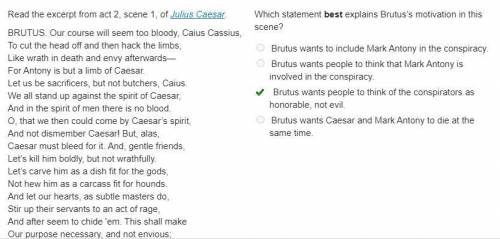Read the excerpt from act 2, scene 1, of Julius Caesar.
BRUTUS. Our course will seem too...

English, 02.03.2020 23:01, sharondot2398
Read the excerpt from act 2, scene 1, of Julius Caesar.
BRUTUS. Our course will seem too bloody, Caius Cassius,
To cut the head off and then hack the limbs,
Like wrath in death and envy afterwards—
For Antony is but a limb of Caesar.
Let us be sacrificers, but not butchers, Caius.
We all stand up against the spirit of Caesar,
And in the spirit of men there is no blood.
O, that we then could come by Caesar’s spirit,
And not dismember Caesar! But, alas,
Caesar must bleed for it. And, gentle friends,
Let’s kill him boldly, but not wrathfully.
Let’s carve him as a dish fit for the gods,
Not hew him as a carcass fit for hounds.
And let our hearts, as subtle masters do,
Stir up their servants to an act of rage,
And after seem to chide 'em. This shall make
Our purpose necessary, and not envious;
Which so appearing to the common eyes,
We shall be called purgers, not murderers.
And for Mark Antony, think not of him,
For he can do no more than Caesar’s arm
When Caesar’s head is off.
Which statement best explains Brutus’s motivation in this scene?
Brutus wants to include Mark Antony in the conspiracy.
Brutus wants people to think that Mark Antony is involved in the conspiracy.
Brutus wants people to think of the conspirators as honorable, not evil.
Brutus wants Caesar and Mark Antony to die at the same time.

Answers: 2
Other questions on the subject: English

English, 21.06.2019 17:20, kayla2945
Which of the following pieces of evidence from gandhi's freedom's battle is most persuasive in support of non- cooperation? a) "i consider that people are better disciplined now than they were before." b) "the danger that attended the civil disobedience does not apply to non-cooperati c) "i do not consider non-cooperation to be unconstitutional." d) "i cannot say a large number has responded to my appeal."
Answers: 1

English, 21.06.2019 23:00, duartealondra45
Read the excerpt from a supporting opinion of the supreme court’s ruling in plessy v. ferguson, 1896. laws permitting, and even requiring, their separation in places where they are liable to be brought into contact do not necessarily imply the inferiority of either race to the other, and have been generally, if not universally, recognized as within the competency of the state legislatures in the exercise of their police power. how does this relate to the premises of brown v. board of education? the brown case addresses whether state legislatures are equipped to judge the quality of education offered at segregated schools. the brown case addresses whether authorities believe that one race is inferior to another when creating public schools. the brown case addresses whether these laws inherently deny certain citizens equal protection under the law. the brown case addresses the legality of using police power to monitor public places separated by race.
Answers: 3


English, 21.06.2019 23:30, delayne22
Select the correct answer. read this excerpt from incidents in the life of a slave girl by harriet ann jacobs: among the ladies who were acquainted with my grandmother, was one who had known her from childhood, and always been very friendly to her. she had also known my mother and her children, and felt interested for them. at this crisis of affairs she called to see my grandmother, as she not unfrequently did. she observed the sad and troubled expression of her face, and asked if she knew where linda was, and whether she was safe. my grandmother shook her head, without answering. "come, aunt martha," said the kind lady, "tell me all about it. perhaps i can do something to you." which of these important concepts uncommon to abolitionist literature does jacobs depict in the excerpt? 1. some kind white characters were included in slave narratives so that northerners would not be offended. 2. southern society was complex and diverse with both good and bad people unlike northern stereotypes showed. 3. many kind slave owners and their slaves developed deep friendships. 4. most whites and blacks lived in harmony in the south and made efforts to each other. a. 1 and 4 b. 1 and 3 c. 1 and 2 d. 2 and 3
Answers: 3
Do you know the correct answer?
Questions in other subjects:


Mathematics, 08.04.2021 19:00

Mathematics, 08.04.2021 19:00


Mathematics, 08.04.2021 19:00


Mathematics, 08.04.2021 19:00









